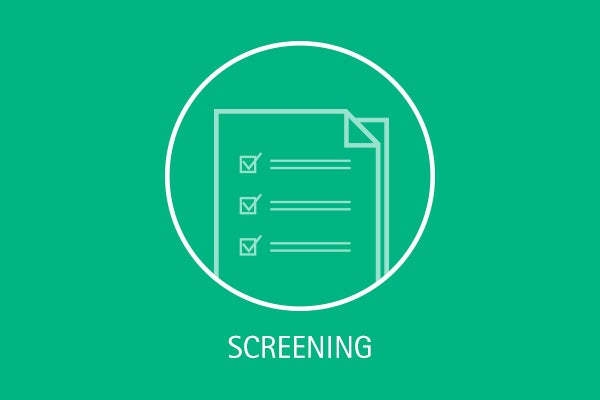Screening tools in oncology
Detecting malnutrition or a risk of malnutrition in cancer patients is crucial for the treatment success. Screening should start at the very beginning after the cancer diagnosis to enable the best possible results of nutrition therapy as support of a holistic anticancer treatment. Moreover, it should be repeated regularly.1
Why are screenings necessary?
Screening is a process to identify the nutritional status of patients and help to determine if a detailed nutritional assessment is indicated.2
The purpose of nutritional screening is to predict the probability of a better or worse outcome due to nutritional factors and should be linked to specified protocols for action, e.g., referral of those patients to an expert for more detailed nutritional assessment and nutrition care plans.3
When should we use screening tools?
The current ESPEN guidelines on nutrition in cancer patients recommend regular assessment of the nutritional intake, weight change and BMI. This should be done at the beginning of the cancer diagnosis and repeated depending on the stability of the clinical situation.1
Which screening tools are recommended?
Every screening tool has its own advantages and which screening tool is recommended differs by clinical nutrition society and/or local dietetic organizations. The recommended nutritional screenings in international references or guidelines for cancer patients are the following:
Overview of 5 sources
NRS-2002
MUST
MUST (Malnutrition Universal Screening Tool) is a validated screening tool for outpatient patients and recommended by the ESPEN and ASPEN.
MNA
MNA (Minimal Nutritional Assessment) is a validated screening tool for geriatric patients and recommended by the ESPEN and ASPEN.
SGA
SGA (Subjective Global Assessment) is a screening assessment tool for different patient groups including cancer patients and recommended by the ESPEN and ASPEN.
PG-SGA
The PG-SGA (Patient-Generated Subjective Global Assessment) and scored PG-SGA are recommended to assess patients with cancer by the ESPEN and ASPEN and widely used by the American Dietetic Association (ADA).
Differences between the 5 most important screening tools
NRS-2002
Nutritional Risk Screening (NRS-2002)
The purpose of the NRS-2002 screening is the detection of malnutrition or risk of malnutrition in adult patients in the hospital setting.
NRS-2002 is based on an initial screening with only four questions (BMI, weight loss, reduced dietary intake and illness). If there is a positive result in one of the four questions, it comes to a final screening, evaluating the impaired nutritional status (weight loss, reduced nutritional intake), the severity of disease, and age in more detail. Three or more points in the final screening means risk of malnutrition.3 The NRS-2002 is recommended by the ESPEN3, ESPEN guidelines for oncology1 and the ASPEN2 as a screening tool for adult cancer patients.
Download NRS-2002 Checklist
MUST
Malnutrition Universal Screening Tool (MUST)
The purpose of the MUST screening is to diagnose malnutrition in adult patients and was originally developed for the outpatient sector. MUST is based on the BMI, current weight loss and acute disease effect. Two or more points mean to treat the patient—or, in other words, it is mandatory to refer the patient to a dietitian.3
The MUST is recommended by the ESPEN3, the ESPEN guidelines for oncology1 and ASPEN2 as a screening tool for adult patients. For more information, see https://www.bapen.org.uk, where you can find a detailed explanation about the MUST, including an option download MUST forms in different languages.
MNA
Minimal Nutritional Assessment (MNA)
Older people with cancer have a high risk of suffering from malnutrition. The Minimal Nutritional Assessment (MNA) has been designed and validated to provide a single, rapid assessment of nutritional status in geriatric patients in outpatient clinics, hospitals, and nursing homes.4
The MNA has not been validated specifically for use in oncology as it is more to identify the frail elderly, as it also includes physical and mental aspects that frequently affect the nutritional status of the elderly.5 It is a combination of a screening and an assessment tool specialized for older people.3
Unfortunately, the MNA does not include nutritional impact symptoms specific to cancer.5 More information about the MNA can be found at www.mna-elderly.com/ where the MNA sheet can also be found in different languages. The MNA is recommended by the ESPEN,3 the ESPEN guidelines for oncology1 and ASPEN2 as a screening tool for geriatric patients.
SGA
Subjective Global Assessment (SGA)
The (SGA) was developed in the '80s and has been used in a wide number of patient populations.5
The SGA contains6:
- history (weight loss, dietary intake, gastrointestinal symptoms and functional capacity),
- metabolic demand of the underlying disease,
- nutrition-related physical examination.
Patients are qualified subjectively into the following groups: Group A = well-nourished, Group B = moderate or suspected malnourished or Group C = severely malnourished.6 The SGA is often used in studies about the nutritional status in cancer patients7,8,9 and is a validated screening tool for patients recommended by the ESPEN10 and ASPEN.2
The SGA is available online from the Canadian Malnutrition Task Force.
Download SGA Checklist
PG-SGA
Patient-Generated Subjective Global Assessment (PG-SGA)
The PG-SGA was adapted from the SGA by Ottery for the oncology population.11 It is the only screening including an assessment that was developed for cancer patients.5
There is also a short form available, called PG-SGA SF. Several clinical studies have been done with these two tools and they are seen as the most ideal and widely used tools to evaluate the nutritional status of patients with cancer.7,12,13,14,15 Therefore, both the ESPEN and ASPEN recommend the PG-SGA.10,1
The PG-SGA has become widely used and popularized as a standard tool for cancer patients by the American Dietetic Association (ADA).7,11
The PG-SGA includes additional questions regarding11:
- the presence of nutritional symptoms,
- the short-term weight loss,
- a physical examination
The components of the medical history can be completed by the patient using a check box format. The physical examination is then performed by a healthcare professional, e.g., physician, nurse or dietitian.11 The scored PG-SGA is a further development of the PG-SGA concept that incorporates a numerical score as well as providing a global rating of well-nourished, moderately malnourished or suspected malnourished or severely malnourished.7
More information about the PG-SGA including the form in various languages can be found at http://pt-global.org/.
References
1 Arends J, Bachmann P, Baracos V, Barthelemy N, Bertz H, Bozzetti F, et al. ESPEN guidelines on nutrition in cancer patients. Clin Nutr. 2017;36(1):11–48.
2 Mueller C, Compher C, Ellen DM. A.S.P.E.N. clinical guidelines: Nutrition screening, assessment, and intervention in adults. JPEN J Parenter Enteral Nutr. 2011;35(1):16-24.
3 Kondrup J. ESPEN Guidelines for Nutrition Screening 2002. Clin Nutr. 2003;22(4):415-21.
4 Vellas B, Guigoz Y, Garry PJ, Nourhashemi F, Bennahum D, Lauque S, et al. The Mini Nutritional Assessment (MNA) and its use in grading the nutritional state of elderly patients. Nutrition. 1999;15(2):116-22.
5 McCallum PD. Nutrition Screening and Assessment in Oncology. In: Oncology Nutrition Dieteic Practice Group, Elliott LE, Molseed LL, McCallum PD, Grant B, editors. The Clinical Guide to Oncology Nutrition: American Dietetic Association; 2006. p. 44-53.
6 Detsky AS, McLaughlin JR, Baker JP, Johnston N, Whittaker S, Mendelson RA, et al. What is subjective global assessment of nutritional status? JPEN J Parenter Enteral Nutr. 1987;11(1):8-13.
7 Bauer J, Capra S, Ferguson M. Use of the scored Patient-Generated Subjective Global Assessment (PG-SGA) as a nutrition assessment tool in patients with cancer. Eur J Clin Nutr. 2002;56(8):779-85.
8 Norman K, Stobaus N, Zocher D, Bosy-Westphal A, Szramek A, Scheufele R, et al. Cutoff percentiles of bioelectrical phase angle predict functionality, quality of life, and mortality in patients with cancer. Am J Clin Nutr. 2010;92(3):612-9.
9 Thoresen L, Fjeldstad I, Krogstad K, Kaasa S, Falkmer UG. Nutritional status of patients with advanced cancer: the value of using the subjective global assessment of nutritional status as a screening tool. Palliat Med. 2002;16(1):33-42.
10 Cederholm T, Barazzoni R, Austin P, Ballmer P, Biolo G, Bischoff SC, et al. ESPEN guidelines on definitions and terminology of clinical nutrition. Clin Nutr. 2017;36(1):49-64.
11 Ottery FD. Definition of standardized nutritional assessment and interventional pathways in oncology. Nutrition. 1996;12(1 Suppl):15-9.
12 Abbott J, Teleni L, McKavanagh D, Watson J, McCarthy AL, Isenring E. Patient-Generated Subjective Global Assessment Short Form (PG-SGA SF) is a valid screening tool in chemotherapy outpatients. Support Care Cancer. 2016;24(9):3883-7.
13 Barao K, Abe Vicente Cavagnari M, Silva Fucuta P, Manoukian Forones N. Association Between Nutrition Status and Survival in Elderly Patients With Colorectal Cancer. Nutr Clin Pract. 2017;32(5):658-63.
14 El-Ghammaz AMS, Ben Matoug R, Elzimaity M, Mostafa N. Nutritional status of allogeneic hematopoietic stem cell transplantation recipients: influencing risk factors and impact on survival. Support Care Cancer. 2017;25(10):3085-93.
15 Ozorio GA, Barão K, Forones NM. Cachexia Stage, Patient-Generated Subjective Global Assessment, Phase Angle, and Handgrip Strength in Patients with Gastrointestinal Cancer. Nutr Cancer. 2017;69(5):772-779.



